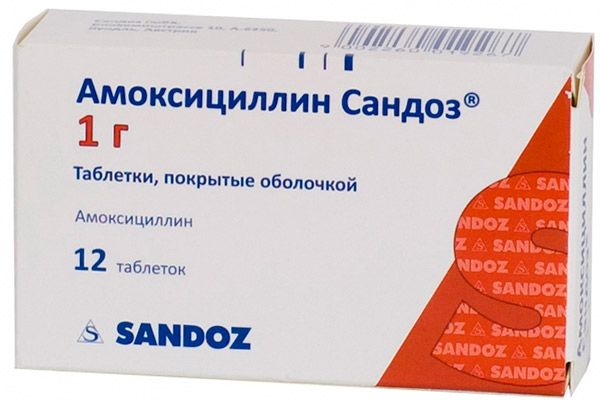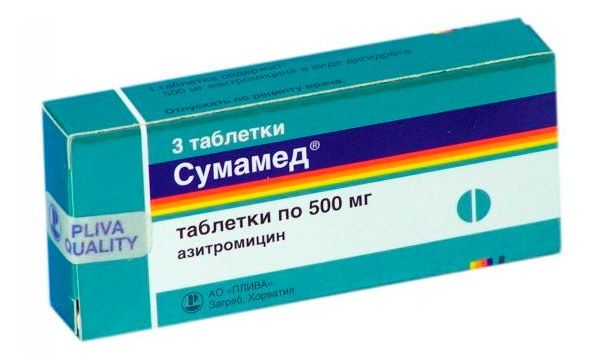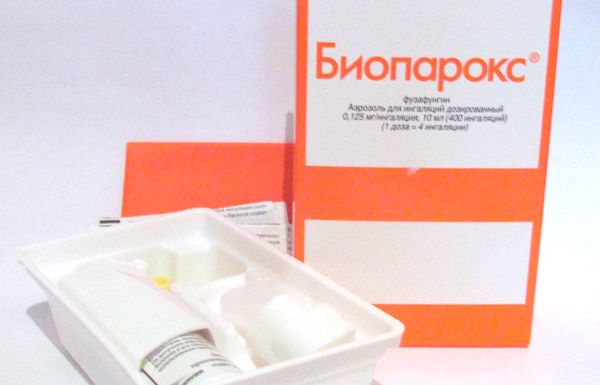Medical expert of the article
New publications
Preparations
Antibiotics for purulent sore throat
Last reviewed: 03.07.2025

All iLive content is medically reviewed or fact checked to ensure as much factual accuracy as possible.
We have strict sourcing guidelines and only link to reputable media sites, academic research institutions and, whenever possible, medically peer reviewed studies. Note that the numbers in parentheses ([1], [2], etc.) are clickable links to these studies.
If you feel that any of our content is inaccurate, out-of-date, or otherwise questionable, please select it and press Ctrl + Enter.
Antibiotics for purulent tonsillitis should be prescribed by a doctor, preferably after a preliminary examination and a test for sensitivity to the drug.
In case of purulent tonsillitis, which arose due to the activity of group A streptococcus, penicillin or derivatives of the drug are usually prescribed. Such drugs are usually taken orally for ten days. In case of bacterial tonsillitis, a single injection of penicillin is used, other derivatives of the drug (augmentin, azithromycin, ampicillin) can also be prescribed for purulent tonsillitis.
Synthetic derivatives of penicillin include Amoxicillin, which does not destroy bacteria but stops their development. The drug prevents the creation of walls that are necessary for the life of bacteria.
Cephalosporins have similar chemical constituents to penicillin.
This antibacterial group includes cephalexin, which prevents the formation of the cell wall, which ultimately leads to the death of bacteria.
In case of allergy to penicillin, erythromycin or tetracycline, which are macrolides, are prescribed.
Erythromycin has a detrimental effect on a large number of pathogenic microorganisms and has an effect similar to penicillin.
Tatracycline destroys protein synthesis and prevents bacteria from producing protein. The drug is a universal drug and is prescribed for penicillin allergy to treat a wide range of bacterial diseases.
Indications for the use of antibiotics for purulent tonsillitis
Antibiotics for purulent tonsillitis are prescribed for almost any form of tonsillitis (except for ulcerative necrotic tonsillitis, which occurs in a mild form, without temperature, fever and affects ulcerative necrotic plaque most often one tonsil). Treatment of purulent tonsillitis requires a comprehensive approach, preferably under the supervision of a doctor, which will prevent possible complications.
Pharmacodynamics of antibiotics in purulent tonsillitis
Antibiotics for purulent tonsillitis of the penicillin series are natural and semi-synthetic. Natural penicillins have a narrow spectrum of action and affect cocci and gram-positive microorganisms. Antibiotics destroy bacteria, have a low toxic effect. However, penicillin antibiotics are strong allergens.
Semi-synthetic penicillins are active against gram-positive cocci that have developed activity against natural penicillins; they are often prescribed for allergies to natural penicillins.
Antibacterial drugs of the macrolide series disrupt the synthesis of bacterial proteins. Drugs from this group suppress the reproduction of pathogenic flora and also penetrate into cells affected by bacteria. Macrolides are active against chlamydia, mycoplasma, ureaplasma, cocci, anthrax, pale treponema, etc.
Among the antibiotics of the cephalosporin group, there are four generations, the first three of which are intended for oral administration and injections. The drugs of this group have low toxicity and high therapeutic effect. Cephalosporin antibiotics are prescribed most often.
Pharmacokinetics of antibiotics in purulent tonsillitis
Antibiotics for purulent tonsillitis from the penicillin group are quickly eliminated from the body (from 30 to 60 minutes), so these drugs need to be administered quite often, especially in severe cases (every 4-6 hours).
Penicillins are well absorbed both when taken orally and when injected. High concentrations of the drug are observed in the kidneys, liver, lungs, muscle and bone tissue.
The effectiveness of injections is 3-4 times higher than that of oral drugs in this group.
The half-life is from 30 to 60 minutes, the drug is excreted mainly by the kidneys.
The absorption of antibacterial drugs of the macrolide group depends on several factors: food intake, form (injections, tablets), type of drug. Food intake reduces the bioavailability of erythromycin several times, practically affects the bioavailability of josamycin, clarithromycin, spiramycin.
The highest concentrations in blood serum are observed for roxithromycin, the lowest for azithromycin.
Macrolide antibiotics bind to blood proteins to varying degrees (roxithromycin binds the most, spiramycin the least). When distributed in the body, different concentrations of the substance are observed in tissues and organs.
Macrolides create high concentrations inside the cell.
Macrolides do not cross the blood-brain barrier well and can penetrate the placenta and into breast milk.
Metabolism occurs in the liver, excretion occurs with bile. When clarithromycin breaks down, a metabolite is formed that has an antimicrobial effect.
The half-life is from 60 minutes to 55 hours.
The half-life parameters do not change in renal failure (with the exception of roxithromycin and cleerithromycin).
Liver cirrhosis may significantly increase the half-life of josamycin and erythromycin.
Oral cephalosporins are well absorbed in the digestive system. Bioavailability in the body depends on the drug (from 40% to 95%).
Food intake may affect the absorption of antibiotics such as cefixime, ceftibuten, cefaclor.
Intramuscular injections also penetrate well into the body. Distribution is observed in almost all organs and tissues. The highest concentrations are observed in muscles, liver, kidneys, etc., as well as in pleural, peritoneal and other fluids.
Ceftriaxone and cefoperazone accumulate maximally in bile.
Drugs in this group penetrate into the fluid inside the eye (especially ceftazidime, cefuroxime), but there is no level for therapeutic effect in the posterior chamber of the eye.
Cephalosporins, especially third generation ones, penetrate the blood-brain barrier and create the concentration necessary for therapeutic effect in the cerebrospinal fluid.
Most cephalosporin antibiotics are not metabolized (with the exception of cefotaxime).
Excretion occurs in urine, sometimes in fairly high concentrations.
Ceftriaxone and cefoperazone are excreted by the liver and kidneys.
The half-life of most cephalosporin drugs ranges from 60 to 120 minutes.
Cefexime, ceftibuten, and ceftriaxone are eliminated longer (up to 9 hours), which means they can be used once a day.
In case of renal insufficiency, dosage adjustment is required (except for cefopezarone and ceftriaxone).
What antibiotics are used for purulent tonsillitis?
Antibiotics for purulent tonsillitis as the main treatment. Antibacterial drugs can be prescribed in the form of tablets or injections (in severe conditions).
Most often, the causative agent of tonsillitis is streptococcus, which is susceptible to penicillins. Doctors usually prescribe ampicillin or amoxicillin for purulent tonsillitis.

Amoxicillin is well tolerated in most cases, and is eliminated from the body quite slowly, so the drug is taken 2-3 times a day, which significantly distinguishes it from other penicillins.
Ampiox, oxacillin, phenoxymethylpenicillin, etc. are also prescribed.
The dosage is calculated depending on the patient’s weight, age, severity of the condition and possible complications.
If you are allergic to penicillin, your doctor may prescribe antibacterial drugs from the macrolide or cephalosporin group.
Of the macrolides, the most commonly prescribed are spiramycin, sumamed, midecamycin, and roxithromycin.

Of the cephalosporins, cefuroxime and cephalexin show good efficiency in purulent tonsillitis. In the development of complications, meropenem or imepenem are used, which are destructive for most pathogenic microorganisms.
In case of purulent tonsillitis, a drug for local treatment may also be prescribed – Bioparox, which contains physafungin. The drug is available as a spray, which is used to treat a sore throat. Bioparox also has an anti-inflammatory effect.
Bioparox is prescribed as part of complex therapy with systemic antibiotics.

The drug is not absorbed into the bloodstream, which is why it is used by pregnant and breastfeeding women.
Antibiotic for children with purulent tonsillitis
Antibiotics for purulent tonsillitis in children are prescribed in case of high temperature (more than 380C), which does not subside for several days, when plaque or pustules are detected on the tonsils, or enlarged lymph nodes in the neck.
Just like adults, children may be prescribed antibacterial drugs from the penicillin, cephalosporin or macrolide group.
Streptococcus is the most common causative agent of purulent tonsillitis, so specialists usually prescribe antibiotics from the penicillin series - ecoclav, amoxiclav, amoxicillin, flemoxin, augmentin. In case of existing allergic reactions to penicillin, macrolides are used - azitrox, sumamed, macropen, hemomycin.
Cephalosporin antibiotics are used only when drugs from the penicillin and macrolide groups have not shown the desired effect.
Usually children are prescribed cephalexin, cefuroxime, cefurus, axetine, suprax, pansef.
Antibacterial therapy lasts from 7 to 10 days (except for sumamed, which is taken for a maximum of 5 days).
 [ 14 ]
[ 14 ]
Method of administration and dosage
Antibiotics for purulent tonsillitis can be prescribed by a doctor in any form: tablets, intravenous or intramuscular injections. The dosage of penicillin antibiotics is determined by the doctor taking into account various factors: the patient's condition, usually the drug is prescribed every 4-6 hours.
The most effective method is intramuscular administration of the drug.
The method of administration and dosage of macrolides depends on the drug and the patient's condition. Tablets are prescribed before meals or regardless of meals 1-2 times a day, antibiotic injections are prescribed once a day. Duration of treatment is 3-7 days.
Cephalosporin drugs in tablet form are prescribed every 6-12 hours.
Injections are prescribed 2-4 times a day. The course of treatment is 7-10 days.
Use of antibiotics for purulent tonsillitis during pregnancy
Antibiotics for purulent tonsillitis of the penicillin series during pregnancy are considered relatively safe. In the early stages, treatment with amoxicillin, amoxiclav is allowed, but antibiotics are prescribed to pregnant women only in cases of extreme necessity. Usually, for purulent tonsillitis, pregnant women at any stage are prescribed an antibacterial drug of local action (bioparox).
Clarithromycin, a macrolide antibiotic, has a negative effect on the fetus, so this drug is not prescribed to pregnant women.
The safety of roxithromycin and midecamycin during pregnancy has not been proven, so the use of these drugs is not recommended.
Erythromycin, josamycin, and spiramycin are prescribed to pregnant women, since no negative effects on the fetus have been identified.
Azithromycin is prescribed to pregnant women only when absolutely necessary.
Cephalosporin antibacterial drugs are used during pregnancy with virtually no restrictions, but no studies have been conducted on the safety of using such drugs.
Contraindications to the use of antibiotics for purulent tonsillitis
Antibiotics for purulent tonsillitis of the penicillin series are contraindicated in cases of allergic reactions in the past to penicillin, bronchial asthma, hay fever, urticaria and other diseases of an allergic nature.
Antibacterial drugs of the macrolide group are not used in case of allergy to this type of antibiotics.
During pregnancy, midecamycin, roxithromycin, and clarithromycin are not prescribed.
Breastfeeding women are not prescribed josamycin, clarithromycin, midecamycin, roxithromycin, spiramycin.
Cephalosporins are not prescribed for allergic reactions to this type of antibiotic.
Side effects of antibiotics for purulent tonsillitis
Antibiotics for purulent tonsillitis of the penicillin series have low toxicity. Their use can provoke allergic reactions, skin rashes, anaphylactic shock, nausea, inflammation of the oral mucosa, bowel disorder, inflammation of the tongue, damage to the mucous membranes, skin or internal organs by Candida fungi. In high doses, the drug causes a state of delirium, convulsions.
The macrolide group of antibiotics is considered the safest type of drugs; side effects are extremely rare.
In some cases, vomiting, nausea, bowel disorder (usually after erythromycin), increased activity of liver transaminases, cholestasis (a type of chronic hepatitis), headaches, dizziness (with intravenous administration of large doses of clarithromycin or erythromycin, hearing impairment is possible), and changes in heart rhythm were recorded. In addition, local reactions are possible: inflammation of the vein walls (possible thrombus formation).
In rare cases, cephalosporin antibiotics can provoke various allergic reactions (rash, itching, bronchospasm, Quincke's edema, etc.), anaphylactic shock, changes in blood composition (increase or increase in the level of platelets, leukocytes, hemoglobin, etc.).
Cefoperazone may cause blood clotting problems and associated bleeding.
Cephalosporins can cause convulsions (at high doses in renal failure), increased activity of liver transaminases, stagnation or decreased secretion of bile, abdominal pain, vomiting, diarrhea with blood, candidiasis of the mucous membranes, as well as local reactions (pain or swelling at the injection site, inflammation of the vein walls, etc.).
Overdose
Antibiotics for purulent tonsillitis of the penicillin series, in case of overdose, as a rule, do not pose a danger to the health and life of the patient. Symptoms of overdose: vomiting, diarrhea. In case of renal failure, increased doses of potassium salt can provoke an increase in the level of potassium in the blood serum.
When administered intramuscularly in high doses (more than 50 million units), an epileptic seizure is possible.
In case of overdose of drugs from the macrolide group and the appearance of characteristic symptoms (dizziness, headaches, nausea, vomiting, diarrhea), urgent gastric lavage is required.
When the drug is administered intramuscularly (intravenously), artificial blood purification is ineffective.
Overdosing on cephalosporins can cause increased excitability of the brain and seizures. Artificial blood purification usually helps to reduce the level of the active substance in the blood serum.
Best before date
Antibiotics for purulent tonsillitis are valid for an average of three years from the date of manufacture, which is usually indicated on the packaging. Antibiotics cannot be used if storage conditions are violated or after the expiration date.
The best antibiotic for purulent tonsillitis
As practice shows, the best antibiotics for purulent tonsillitis are from the penicillin series. Usually, doctors prefer augmentin or amoxicillin.
In case of allergy to penicillin, drugs of the macrolide group are prescribed.
Lastly, if treatment with the two previous groups of drugs has not produced the expected effect, cephalosporins are prescribed.
Antibiotics for purulent tonsillitis are the main method of treating the disease, which will help quickly cope with the infection and prevent possible complications. The most common pathogens of tonsillitis are streptococci and staphylococci, if treated incorrectly, they can lead to severe complications, in particular the development of rheumatism (especially in childhood).
Attention!
To simplify the perception of information, this instruction for use of the drug "Antibiotics for purulent sore throat" translated and presented in a special form on the basis of the official instructions for medical use of the drug. Before use read the annotation that came directly to medicines.
Description provided for informational purposes and is not a guide to self-healing. The need for this drug, the purpose of the treatment regimen, methods and dose of the drug is determined solely by the attending physician. Self-medication is dangerous for your health.

